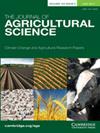Evaluation of Mungbean Varieties for Adaptation to Rice-Based Cropping Systems and Profitability in North-West Cambodia
IF 2.2
4区 农林科学
Q2 AGRICULTURE, MULTIDISCIPLINARY
引用次数: 0
Abstract
Two varieties of mungbean (Vigna radiata (L.) Wilczek) are most commonly grown in Battambang Province North-West Cambodia: KPS-2 (Thailand); and DX-208 (Vietnam). From the buyer’s point of view, the ideal variety would have large shiny seeds and from the farmer’s point of view, resistance to pod-shattering for single-pick or mechanical harvesting is a priority. KPS-2 has resistance to pod-shattering but small seeds and DX-208 has large seeds but has pods that shatter readily. The ideal variety would have both traits. This study evaluated 17 released mungbean varieties from Cambodia, Thailand, Vietnam and Australia for grain yield, seed weight and resistance to pod-shattering in a series of experiments from 2019 to 2021. In 2019, the four Cambodian varieties were evaluated alongside 11 Australian public varieties. Five of the Australian varieties were rejected because of low seed weight, dull seed coat and unacceptable color. Cambodian variety CMB-1 was rejected because of dull seed coat and indeterminate maturity. In 2021, the six remaining Australian varieties were re-evaluated together with locally grown varieties (DX-208, KPS-2) and Cambodian varieties (CARDI Chey, CMB-2 and CMB-3). The seed weight for Emerald was very similar to that for DX-208. Seed weights for CARDI Chey, CMB-3, King and Shantung were not significantly different to KPS-2. In laboratory testing for resistance to pod shattering, Delta, Emerald and KPS-2 were the most resistant and DX-208 was the most susceptible to pod shattering. The Australian varieties Delta and Emerald are recommended for further testing across other mungbean growing regions of Cambodia before submission for registration and commercial release.柬埔寨西北部绿豆品种适应稻作制度及效益评价
绿豆(Vigna radiata, L.)的两个变种Wilczek)最常见于柬埔寨西北部的马德望省;KPS-2(泰国);DX-208(越南)。从买家的角度来看,理想的品种应该有大而有光泽的种子,而从农民的角度来看,单穗或机械收割时抗豆荚破碎是最重要的。KPS-2抗豆荚破碎,但种子小,DX-208种子大,但豆荚容易破碎。理想的品种应该同时具备这两种特征。本研究通过2019年至2021年的一系列试验,对柬埔寨、泰国、越南和澳大利亚17个已发布的绿豆品种的籽粒产量、种子重量和抗碎荚性进行了评价。2019年,四个柬埔寨品种与11个澳大利亚公共品种一起进行了评估。5个澳大利亚品种因种子重量低、种皮暗淡和颜色不合格而被拒收。柬埔寨品种CMB-1因种皮暗沉、成熟度不确定而被拒收。2021年,对剩下的6个澳大利亚品种以及当地种植的品种(DX-208、KPS-2)和柬埔寨品种(CARDI Chey、CMB-2和CMB-3)进行了重新评估。祖母绿的种子重量与DX-208非常相似。CARDI - Chey、CMB-3、King和山东的种子重与KPS-2差异不显著。在室内抗落荚试验中,Delta、Emerald和KPS-2对落荚的抗性最强,DX-208对落荚最敏感。在提交注册和商业发布之前,建议在柬埔寨其他绿豆种植区对澳大利亚品种Delta和Emerald进行进一步测试。
本文章由计算机程序翻译,如有差异,请以英文原文为准。
求助全文
约1分钟内获得全文
求助全文
来源期刊

Journal of Agricultural Science
农林科学-农业综合
CiteScore
2.80
自引率
5.00%
发文量
68
审稿时长
1.4 months
期刊介绍:
The Journal of Agricultural Science publishes papers concerned with the advance of agriculture and the use of land resources throughout the world. It publishes original scientific work related to strategic and applied studies in all aspects of agricultural science and exploited species, as well as reviews of scientific topics of current agricultural relevance. Specific topics of interest include (but are not confined to): all aspects of crop and animal physiology, modelling of crop and animal systems, the scientific underpinning of agronomy and husbandry, animal welfare and behaviour, soil science, plant and animal product quality, plant and animal nutrition, engineering solutions, decision support systems, land use, environmental impacts of agriculture and forestry, impacts of climate change, rural biodiversity, experimental design and statistical analysis, and the application of new analytical and study methods (including genetic diversity and molecular biology approaches). The journal also publishes book reviews and letters. Occasional themed issues are published which have recently included centenary reviews, wheat papers and modelling animal systems.
 求助内容:
求助内容: 应助结果提醒方式:
应助结果提醒方式:


